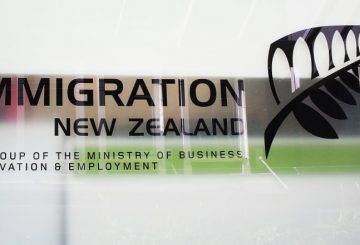到明年年底,新西兰将接待新居民人数的五倍,这是政府所说的 “有史以来最大的移民决定”。
移民部长克里斯·法菲奥说,他希望 165,000 名移民及其家人将新西兰作为家园,这一举动受到商业,农业和卫生部门的欢迎。
但是移民更加谨慎,他们说 “健康的怀疑主义” 和对细节的不确定性将使他们的庆祝活动暂停。
那些工作需要注册的人(例如教师和护士)或每小时工资超过 27 美元的人都可以申请,大多数在这里待了三年以上的移民工人也可以申请。
一旦明年有管理的隔离能力成为可能,海外的合作伙伴和孩子将能够加入他们的行列。
等待居住的人中有大约 3000 名医生和护士。
Kāpiti GP 安妮·所罗门已经等了一年,无法为她的五口之家申请居留权。没有它,今年要离开学校的一个女儿就无法工作。她的长女正在上大学。
“实际上,对我们来说,最可怕的前景是它使家庭分崩离析。你知道,一个人必须离开,另一个已经安定下来,你开始希望自己永远不会来,因为这是你想发生的最后一件事。它损害了你准备保护的东西以及你想要确保的孩子的未来。”
她补充说,Covid-19 加剧了不确定感。
“这是一个非常脆弱的时期,它以很难写出来的方式影响你的情感,但是不安全感是相当深刻的。我们已经等待验证和澄清一年多了,他们已经将其推向了更低的水平。
“显然,如果我乐观的话,听起来确实有些事情在动人,但是现在有一种学会的怀疑论-直到我们看到它在手中,我们才会真正相信它,但我们想相信它。
“但这可能还需要 14 个月,因为现在是你申请的是 12 月,然后可能需要一年的时间。是的,这是个好消息,但我们必须保持这种健康的怀疑态度,直到我们真正看到结果为止,然后会松一口气。”
新西兰移民局有 54,000 名会员,其创始人之一安娜·伯格哈特(Anna Burghardt)说,今天她被快乐或焦虑的人的电话和消息所淹没。
有人说,他们决心在明年年底之前不对居留承诺抱有希望,并担心他们会加入新的队列。
呼吁道歉
IT 顾问萨蒂什·巴马尔(Satish Bamal)于 8 月获得居留权,他说,他的感觉复杂-为受影响的人感到高兴,但其他人却不得不经历这样的磨难感到失望。
“道歉真的很好,因为遭受了很多痛苦,遭受了很多精神折磨,而且必须处理所有的压力和不确定性,所以道歉肯定是惊人的。”
Faafoi 拒绝了他今天应该道歉的建议。
“我们承认人们所经历的困难,但我认为今天早上,他们醒来时已经有了一个相当全面的解决方案,以解决他们和雇主所面临的一些不确定性。”
移民顾问戴维·库珀说:“实际上,我认为这应该是道歉而不是简单的承认,因为人们一直在受伤。”
“我认为这将带来巨大的不同,因为如果你一直坐在新西兰,并且你已经有 18 个月或两年没有拥抱孩子了,而皇室大臣站起来说,’对不起,我们最终到了那里,如果这伤害了你,我真的很抱歉,但我们正在前进’。
“我认为,这将大大有助于使那些一直在努力工作以继续帮助新西兰在 Covid 期间继续奔跑的移民对他们可能选择定居的地方感觉好多了。”
但是活动经理汤姆·芬金认为道歉是空洞的。他自 2017 年以来一直在新西兰,并于 2019 年 11 月申请,为一家慈善机构工作,然后搬到瓦纳卡。他将移民过程描述为艰巨的旅程。
“我为现在不必经历我们所做的事情的每个人感到非常高兴。但这真是苦乐参半。事实上,我们只需要付出这么多钱,要做很多事情才能到达这里,然后突然之间他们只会说 “哦,甜蜜的,这是其他人居住的途径”。
“这确实是可以预见的。2018 年有积压,所以到 2019 年没有任何事情发生。这肯定是对经济的重大打击,因为像我这样的人可能已经离开,他们本来可以真正做出贡献,并真正帮助这些公司利用我们从另一个国家带来的技能做出更多的贡献。”
新西兰移民局表示,像他这样的申请将继续处理,而不是等待新的居留途径。
Faafoi 表示,这些申请将分两个阶段处理,12 月份的申请优先考虑已经在队列中的居留申请,以及包括 17 岁及以上青少年在内的 EOI 的申请,以确保他们对工作和学习的确定性。
过去三年签发了 100,000 份居留签证,并承诺在 12 个月内批准 165,000 个居留签证,有些人对遵守时间表表示怀疑。
库珀说:“他们目前队列中有 11,000 或 12,000 个应用程序,他们现在无法管理这些应用程序。”
“他们将如何管理这165,000个申请?我们已经听到了人们的来信,他们所表达的担忧是为什么申请延迟,人们实际上会在一年之内迅速通过该系统的信心在哪里?
“尽管如果移民没有资源,我们将进行简化,但我们只会创建另一个队列。”
来源:RNZ 新闻






























































